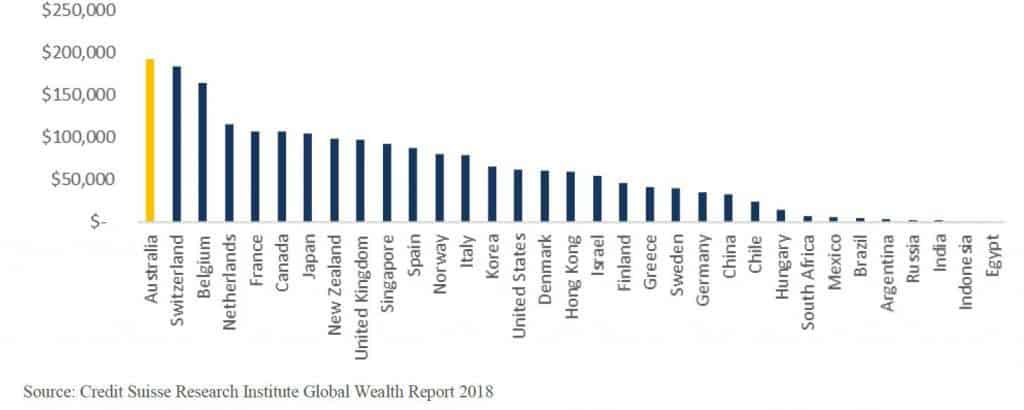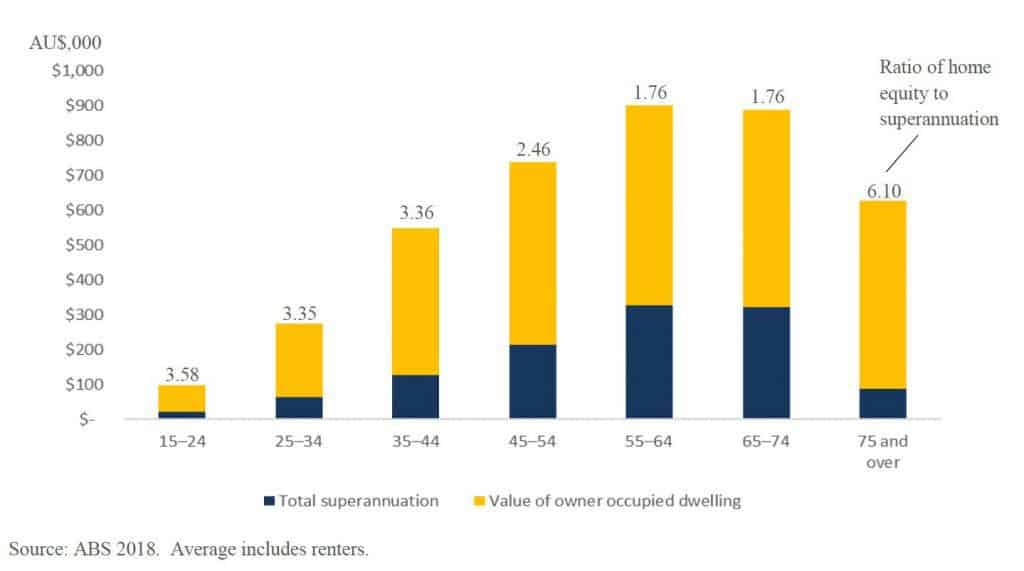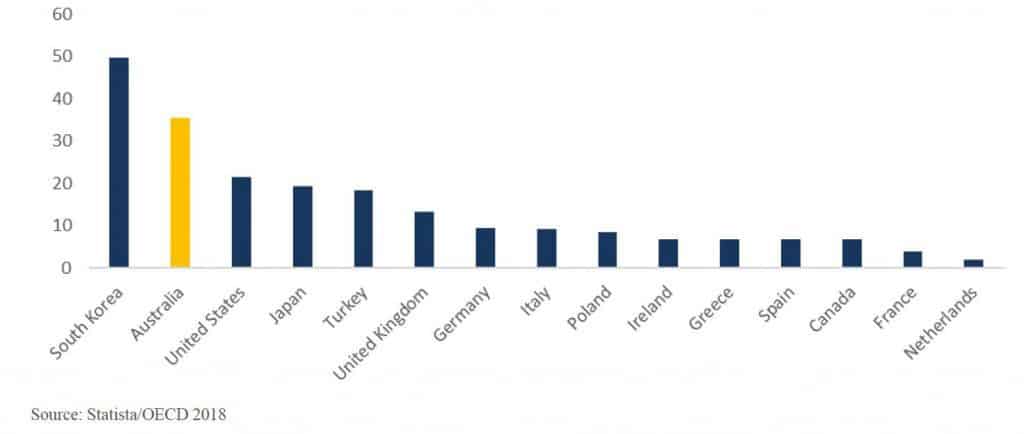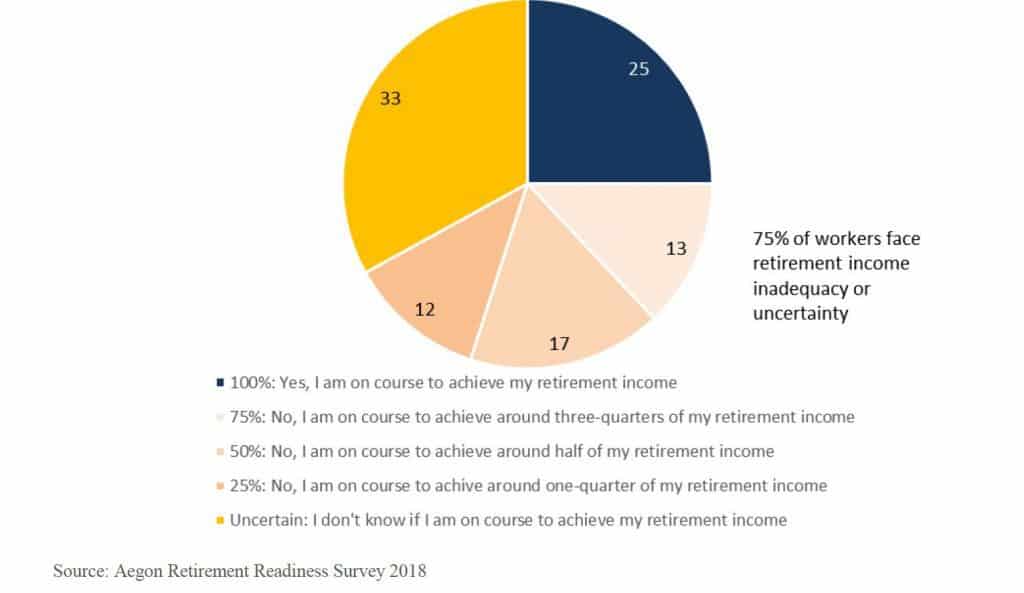While the United States has more millionaires than any other country in the world, Australia has the greatest median wealth per head, significantly ahead of the millionaire-rich US.
Median wealth per adult

Despite this, Australians also experience higher than average levels of relative poverty in retirement (figure two). This begs the question…how can a wealthy nation with broadly distributed wealth fail to deliver adequate retirement outcomes for so many of its retired citizens?
The percentage of 65 years plus experiencing relative poverty in retirement
The answer? For many older Australians, the majority of their wealth is tied up in their family home. Although 80% of Australians own their own home at retirement and share a strong desire to remain at home throughout retirement, our national economic system has failed to provide adequate access to home equity wealth to improve retirement funding.
Improve retirement funding
To enjoy more good years of life in retirement, adequate resources are required. The Australian superannuation system was designed to supplement the pension with private savings from wage contributions. While the total superannuation savings required to fund an adequate lifestyle for baby boomers is contested, the introduction of superannuation contributions occurred only part-way through their careers at lower levels…a 3% annual contribution in 1987, followed by the Superannuation Guarantee increasing to 9% by 2002. This has led to a major shortfall in available assets to fund retirement. “If you truly want to become independent of the government, a self-funded retiree, live off superannuation, you’re going to have to put your own money in. The occupational superannuation is not going to do it.” – Peter Costello, 7.30 Report, 8 April 2019 Figure 3 shows the total average superannuation versus home equity for Australian households during the course of work and retirement. Within 10 years of retirement, superannuation savings are largely depleted. For Australian homeowners at retirement, the average household home equity is typically almost twice the value of superannuation. By the time retired cohorts have reached 75+ years of age, home equity savings have grown to over six times the value of superannuation. On average, Australians’ superannuation lasts about 10-15 years after which many Australians in retirement can expect a further 10-15 years of underfunded or inadequate retirement supported by the Age Pension.
Average net assets per household

Retirement income inadequacy
As detailed in figure four, 75% of older Australians face income inadequacy or uncertainty, undermining both confidence and wellbeing throughout retirement. The combination of inadequate and uncertain retirement funding leads to a gap in retirement incomes.
Expectations of retirement income adequacy
The outcome of uncertain and inadequate retirement funding is profound. Individual retirees face harder lives, diminished dignity and independence, reduced confidence, less active retirement, worse health outcomes and intentional under-consumption for their own wellbeing. Poorly funded retirement also has major implications for national social and economic objectives.
Looking forward
A key recent change in national policy on ageing has been the switch from viewing longevity as a “grey tsunami” and “budget threat” to celebrating an historically unprecedented new phase of life as part of “longevity and positive ageing”. To take advantage of 30 years of retirement, we must address social and economic policy. First, in social policy, healthcare and community connectedness are essential to retirement outcomes. Retirees with greater incomes and more confidence in their ability to fund retirement will be more active, healthier, and happier. Second, in economic policy, appropriate housing (including aged care) and funding for retirement are essential. Australian retirees intend to live long, healthy lives at home. Household Capital’s mission is to provide widely available solutions for retirement housing and funding by providing a universal finance function between housing and retirement. Australian retirees have saved more than one trillion dollars in home equity and should be able to draw on those savings to Live Well At Home.
Household Capital Pty Limited ACN 618 068 214 is the issuer of the information on this website. Household Capital Pty Limited ACN 618 068 214, Australian Credit Licence 545906, is the Servicer for the credit provider Household Capital Services Pty Limited ACN 625 860 764. HOUSEHOLD CAPITAL, HOUSEHOLD TRANSFER, LIVE WELL AT HOME and the Star Device are trademarks of Household Capital Pty Ltd
You may also like








